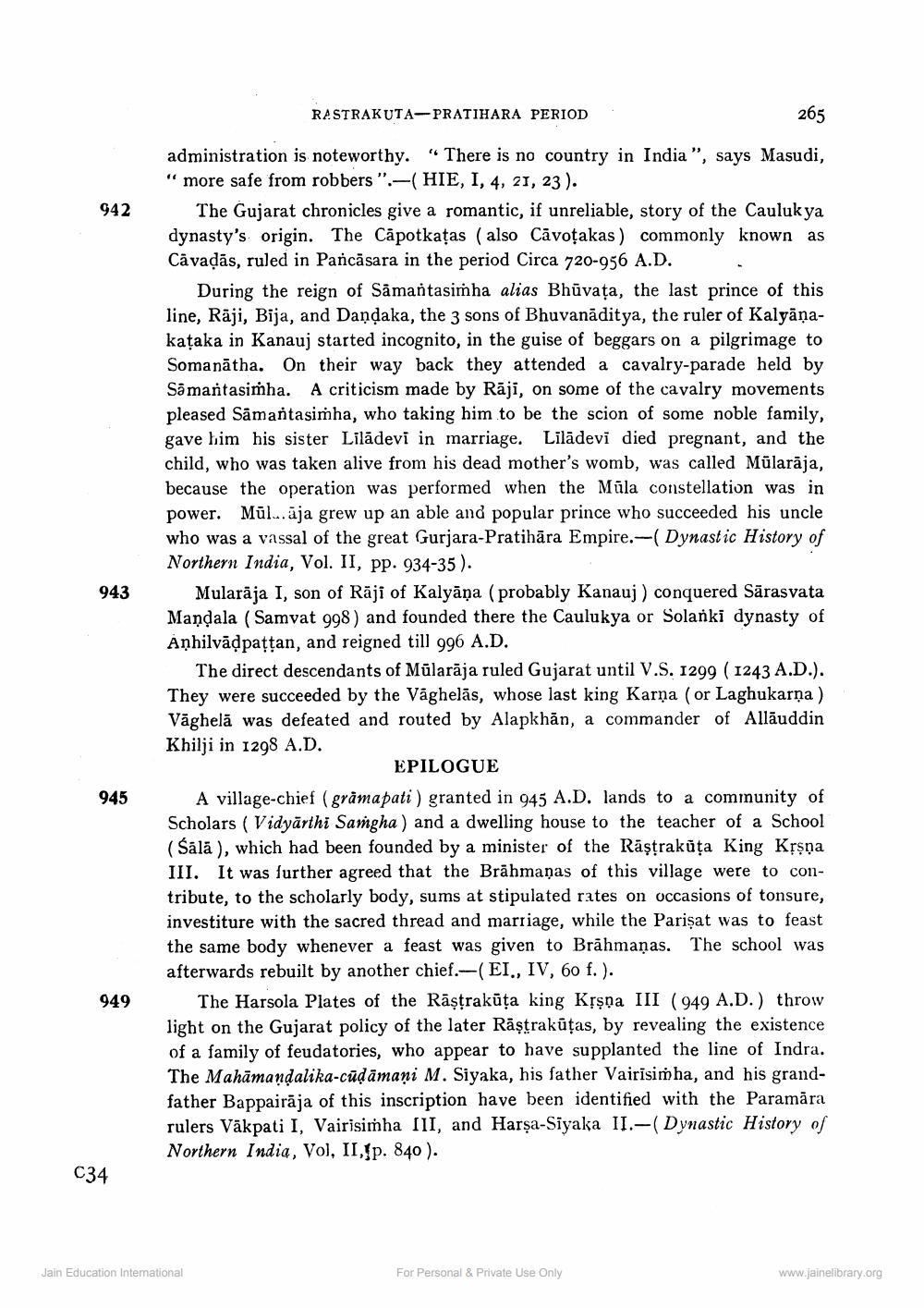________________
942
943
RASTRAKUTA-PRATIHARA PERIOD
265 administration is noteworthy." There is no country in India ", says Masudi, "more safe from robbers":-( HIE, I, 4, 21, 23).
The Gujarat chronicles give a romantic, if unreliable, story of the Caulukya dynasty's origin. The Cäpotkațas (also Cāvođakas) commonly known as Cavadās, ruled in Pancasara in the period Circa 720-956 A.D.
During the reign of Sämantasimha alias Bhūvața, the last prince of this line, Rāji, Bija, and Dandaka, the 3 sons of Bhuvanāditya, the ruler of Kalyāņakațaka in Kanauj started incognito, in the guise of beggars on a pilgrimage to Somanātha. On their way back they attended a cavalry-parade held by Samantasimha. A criticism made by Rāji, on some of the cavalry movements pleased Sāmantasimha, who taking him to be the scion of some noble family, gave him his sister Lilādevi in marriage. Lilādevi died pregnant, and the child, who was taken alive from his dead mother's womb, was called Mūlarāja, because the operation was performed when the Müla constellation was in power. Mül..aja grew up an able and popular prince who succeeded his uncle who was a vassal of the great Gurjara-Pratihāra Empire.-( Dynastic History of Northern India, Vol. II, pp. 934-35).
Mularāja I, son of Rāji of Kalyāņa (probably Kanauj) conquered Sārasvata Mandala (Samvat 998) and founded there the Caulukya or Solanki dynasty of Anhilvāļpațţan, and reigned till 996 A.D.
The direct descendants of Mūlarāja ruled Gujarat until V.S. 1299 ( 1243 A.D.). They were succeeded by the Vaghelās, whose last king Karņa (or Laghukarņa ) Vāghelā was defeated and routed by Alapkhăn, a commander of Allāuddin Khilji in 1298 A.D.
EPILOGUE A village-chief (grāmapati) granted in 945 A.D. lands to a community of Scholars (Vidyārthi Samgha) and a dwelling house to the teacher of a School ( Sālā ), which had been founded by a minister of the Răştrakūta King Krşņa III. It was further agreed that the Brāhmaṇas of this village were to contribute, to the scholarly body, sums at stipulated rates on occasions of tonsure, investiture with the sacred thread and marriage, while the Parişat was to feast the same body whenever a feast was given to Brāhmaṇas. The school was afterwards rebuilt by another chief.—(EI., IV, 60 f.).
The Harsola Plates of the Rāstrakūta king Kșşņa III (949 A.D.) throw light on the Gujarat policy of the later Răstrakūtas, by revealing the existence of a family of feudatories, who appear to have supplanted the line of Indra. The Mahāmandalika-cūļāmaņi M. Siyaka, his father Vairīsimha, and his grandfather Bappairāja of this inscription have been identified with the Paramāra rulers Vākpati I, Vairisimha III, and Harșa-Siyaka II.-( Dynastic History of Northern India, Vol. II, p. 840 ).
945
949
C34
Jain Education Interational
For Personal & Private Use Only
www.jainelibrary.org




